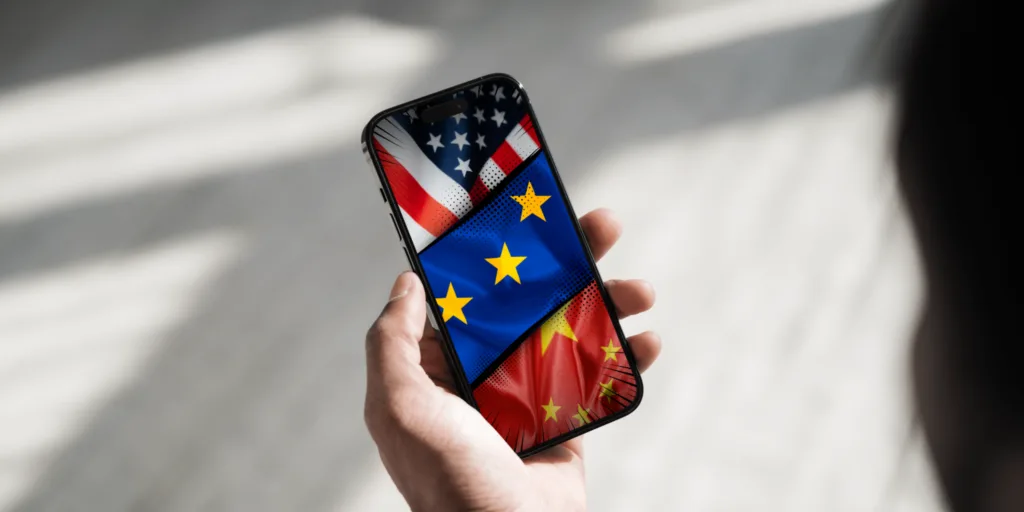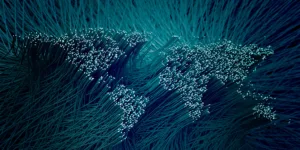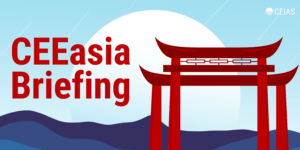Key takeaways:
-
Social media discourse in the Visegrad Four (V4) countries on the EU-China-US triangle amid changes in American foreign policy reflects deep domestic divisions about the shape of the EU’s foreign policy and the values it should project in the international arena.
-
Chinese actors play a limited role in shaping the discourse on the ongoing geopolitical developments, maintaining focus on presenting a positive image of China as a stable and responsible global power.
-
The US criticism of the EU is instrumentalized by Eurosceptic voices who portray the EU as lagging behind in geopolitical competition between the United States, China, and Russia, and advocate for rethinking ties with all powers.
Introduction
This situation report maps social media discourse about China in the Visegrad Four (V4) states—Czechia, Hungary, Poland, and Slovakia. It is the third situation report in the project “Investigating China-related narratives in the Central European information space”, implemented by CEIAS in cooperation with Matej Bel University, supported by the European Media and Information Fund (EMIF).
Using Gerulata Juno, a unique online dashboard that monitors social media platforms, this report analyzes discourse related to the EU-China-US geopolitical triangle between January 1 and March 15, 2025. This period saw dramatic changes in US foreign policy following the return of Donald Trump to the White House and his administration’s swift reconfiguration of long-standing alliances, including the transatlantic partnership with Europe. As Washington intensifies pressure on the EU on trade and security issues, divisions across the bloc, including in Central Europe, have become more pronounced on how to deal with China. Beijing sees the transatlantic rift as a window of opportunity to repair its image and strengthen ties with the EU, which have been strained in recent years by disputes over trade, security, and values.
The data is filtered to only include posts with more than 50 interactions and excludes irrelevant data such as incidental references to the issue at hand. The report is divided by country and, within each chapter, by discussions among three groups: China-affiliated media and official accounts publishing in the local language of the respective V4 country; local political discourse; and a broader online debate, with a special focus on “alternative media” and anti-system voices.
The analysis draws on a preexisting corpus of accounts monitored by Gerulata, supplemented by a project-specific mapping of accounts relevant to discussions on China: China-affiliated groups; major political parties and politicians; key mainstream media; social media influencers; and those previously tied to alternative and anti-system sources. The final corpus encompassed more than 3,400 sources in Czechia, 1,300 in Hungary, 8,500 in Poland, and 3,200 sources in Slovakia. Unique search strings were developed in each language using Boolean operations, focusing on keywords such as “US/Washington”, “EU/Brussels”, “China/Beijing” (and their variants). Posts were then manually filtered to exclude irrelevant content.
Czechia: Rethinking foreign policy amid the great power competition/cooperation
This report analyzes social media discourse surrounding the EU–China–US triangle in the period immediately before and after Trump’s inauguration. The findings are based on a sample of the 425 most popular Czech-language posts, drawn primarily from Facebook, YouTube, X and other platforms.
Chinese accounts
The official accounts of the Chinese Embassy in Prague did not directly engage with the evolving dynamics of the EU–China–US triangle. Instead, they focused on portraying China as a reliable global actor amid shifting geopolitical currents. One notable post, captioned “Certainty in uncertain times: The role of China in stabilizing the world,” featured an infographic highlighting China’s contributions to UN peacekeeping missions. Another post quoted Chinese Foreign Minister Wang Yi via the Foreign Ministry spokesperson: “China will provide certainty to this uncertain world.” Aside from these, most of the Embassy’s content adhered to typical themes—promoting Chinese geography and culture—which drew limited engagement.
The Czech-language Facebook account of CRI published several posts, though none reached the 50-interaction threshold required for inclusion in the dataset. Nevertheless, the narratives conveyed warrant attention, as they offer insights into China’s official messaging. One post featured an interview with Bogusław Liberadzki, an economist and former vice-president of the European Parliament, in which he urged the EU to avoid blindly aligning with the United States and to strengthen its strategic autonomy. Another post highlighted China’s commitment to climate action, stating it would “actively address climate change and, together with other parties, promote the global transition to a green and low-carbon transformation.” This is a clear contrast to President Trump’s decision to withdraw the US from the Paris Agreement. Given the political nature of these themes, CRI-affiliated Czech-language influencers such as Lada Wang and Pepa Zhang have refrained from engaging with the topic, instead continuing to focus on non-political cultural and travel content.
Domestic political actors
As noted in our first situational report on electromobility, narratives surrounding China in Czechia are closely intertwined with broader opposition to the EU’s Green Deal—a stance common among Czech opposition parties. For example, Tomio Okamura, leader of the far-right Freedom and Direct Democracy (SPD) party, praised Trump’s climate policies and argued that the EU should similarly abandon the Green Deal, warning that Europe risks becoming uncompetitive compared to the US, China, and other global players. Okamura also criticized Prime Minister Petr Fiala’s foreign policy for alienating all major powers, including the US, Russia, and China, thereby rendering Czechia “irrelevant” on the international stage. His party colleague, Radim Fiala, echoed this sentiment in a shared clip from an SPD press conference in the Lower House of Parliament, lamenting the lack of Czech-Chinese relations despite China being one of the world’s largest economies.
Similarly, Andrej Babiš, leader of the main opposition party ANO, has consistently criticized the Fiala government for its overtures to Taiwan and lack of engagement with China. In his online show, Babiš claimed that Czech foreign policy is no longer taken seriously internationally: “While everyone is going to China, we are the only ones going to Taiwan,” he said, arguing that this harms Czech businesses. During a live podcast event, he reiterated that the government had damaged trade ties with China and negatively impacted Czech companies operating there.
These positions were mirrored in a televised debate on CNN Prima News, where two Members of the European Parliament clashed over how the EU should navigate Trump’s return to the White House. Tomáš Zdechovský of the governing KDU-ČSL advocated for greater EU self-sufficiency, arguing that the bloc should prevent China from benefiting from the Green Deal and limit imports of cheap Chinese goods. In contrast, Ondřej Dostál of the far-left Stačilo! coalition called for a strategic pivot toward Eurasian markets, including China, if Trump treats the EU the same way he treats Canada or Mexico. At one point, Dostál provocatively claimed that the Chinese leadership is more competent than the European Parliament’s. Zdechovský responded sarcastically, inviting him to “enjoy the fresh air in Beijing.” Their exchange quickly escalated into a broader argument over economic development and labor standards, with Dostál insisting that China is on the rise while the EU is in decline.
Kateřina Konečná, an MEP and leader of the Communist Party of Bohemia and Moravia (KSČM), now part of Stačilo!, used her Facebook page to report on a visit to China, expressing optimism that Czechia could find common ground with “this economic tiger” once the current government is replaced. In another post, she welcomed the dismantling of USAID, accusing the agency of destabilizing governments and funding protests in countries resisting the “globalist agenda.” She further alleged, citing US Secretary of Health Robert F. Kennedy, Jr., that American funds supported biological weapons and coronavirus research at the Wuhan Institute in 2019.
Ondřej Dostál, also affiliated with Stačilo!, argued in a separate post that rather than rearming, the EU should strengthen relations with all major global powers, including the US, China, and Russia, and benefit from mutually advantageous trade with BRICS countries. He contended that there are no insurmountable security obstacles to cooperation with China.
Finally, figures from the far-right, including Ivan David, an MEP for SPD, and Zuzana Majerová of the Trikolóra movement, praised US Vice President Vance’s speech at the Munich Security Conference. They highlighted his statement that the gravest threat to Europe is not posed by China or Russia but by internal decay and a departure from foundational European values.
Alternative media outlets and fringe actors
In the alternative information space, Vance’s speech, particularly the portion emphasizing that the greatest threat to Europe comes from within, resonated strongly. The statement was widely shared, including by Raptor TV, an internet channel known for promoting Russian propaganda.
Amid the broader geopolitical shifts and changes in US foreign policy, several fringe media platforms offered divergent takes on Europe’s positioning. Some advocated for closer cooperation with China, while others condemned what they saw as EU hypocrisy in seeking alignment with Beijing. For instance, the YouTuber behind the pro-Russian channel Doktor Vajíčko (Doctor Egg), which boasts over 44,000 subscribers, argued that, in response to recent US foreign policy shifts, the EU should align itself more closely with BRICS and “build a wall together.”
Conversely, Inovace Republiky, an anti-vaccine, pro-Chinese, and pro-Russian YouTube outlet, featured a video in which Petr Kratochvíl, a Czech Trump supporter, criticized EU leaders for what he saw as double standards. Citing perceived overtures by Ursula von der Leyen and Emmanuel Macron toward China, Kratochvíl warned that the EU is on a trajectory that would see it siding with authoritarian regimes such as China or North Korea against democratic nations like the US, Canada, and Argentina.
Another video, posted by a pro-Russian YouTube channel affiliated with the disinformation website Svědomí národa (Consciousness of a Nation), featured economist and known conspiracy theorist Peter Staněk. In the interview, Staněk outlined his vision of a new world order emerging in 2025, led by three “firsts among equals”: China, Russia, and the United States. He forecasted that the US would dominate the Americas, Russia would take hold of Europe, and that most countries would eventually align themselves with the “Shanghai Group.” Notably, Staněk also referenced the racist “Yellow Peril” theory, suggesting a future Chinese global takeover—a deeply problematic narrative rooted in xenophobic ideology.
The theme of a world divided into spheres of influence, with the EU and Czechia fading into irrelevance, recurred across the fringe discourse. One Facebook user lamented Europe’s direction, claiming that while the US, China, and Russia are engaged in disarmament and redirecting military budgets toward “more meaningful” ends, Europe is once again heading in the opposite direction: “rearming, rearming, rearming.”
The aforementioned Inovace Republiky also featured an interview with Czech economist Ilona Švihlíková, who is associated with both the far-right SPD and the far-left Stačilo! coalition. In the interview, she discussed the World Economic Forum in Davos, referencing a panel on EU–China–US relations. According to Švihlíková, a Chinese delegate advised the EU to pursue balanced relations with both powers and remain flexible. She endorsed this position, mocking the EU’s frequent invocation of abstract “values” and calling instead for more pragmatic engagement.
Švihlíková also appeared in one of the most widely shared videos in the dataset — a clip from CNN Prima News that circulated first on TikTok and later on Facebook. In the video, she criticized the EU’s push to boost defense spending. Citing data from the Stockholm International Peace Research Institute (SIPRI), she argued that NATO countries, led by the US, already have vast defense budgets, whereas countries like China and Russia spend comparatively less but use their resources more effectively. She called the Czech government’s plan to raise defense spending to 2.2 percent of GDP a “completely perverse idea.” However, SIPRI’s 2024 report indicates that in 2023, Russia’s military spending amounted to 5.9 percent of GDP, and that China was the second-largest military spender globally, complicating the narrative of relative restraint.
Hungary: Geopolitical narratives of European self-isolation and decline
After setting a minimum of 50 interactions as a filtering requirement, the query returned 531 relevant results. The overall number of results showed a growing tendency from January 1 to late February, reaching a peak on February 17. After a plateau lasting until February 24, it started to decline. The main factor behind the rise and decline of posts was Trump’s launch of his controversial Ukraine policy. During this period, Trump took initial steps to launch negotiations with Russian President Vladimir Putin, and the main contours of the new administration’s approach to Ukraine were publicly outlined. These developments sparked broader conversations about shifting global dynamics, including China’s potential role in the emerging international order.
Chinese state actors play a marginal role
Chinese state actors and state media played only a marginal role in the analyzed discourse. Relevant channels, such as the Chinese embassy in Budapest and the Hungarian edition of CGTN/CRI, did not produce any content with at least 50 interactions. This aligns with previous findings that Chinese state-controlled sources have a limited impact on shaping China-related narratives within the Hungarian social media landscape.
Domestic political actors
While domestic political actors were not as prominent as media platforms or influencers, several of their accounts ranked among the 11th to 30th most active regarding interaction volume and content creation. Prime Minister Viktor Orbán appeared with one post each on his Facebook, YouTube, and Instagram accounts. His most engaged post, a Facebook post on February 14 that garnered approximately 5,800 interactions, featured his regular interview with Hungary’s state radio. In the interview, Orbán welcomed Trump’s return as a step toward reaffirming national sovereignty and criticized the EU for pursuing what he described as anti-sovereignty and isolationist foreign policies. He contrasted this with Hungary’s vision of global interconnectivity, emphasizing partnerships with major and emerging “power centers” such as the US, China, Asian countries, and the Arab world.
Other high-performing political accounts included that of Foreign Minister Péter Szíjjártó. His February 27 Facebook post, which received 6,223 interactions, advanced the narrative that Hungary had previously warned Brussels to reduce its tariffs on American cars (then at 10 percent, compared to the US’s 2.5 percent on some European models). Szíjjártó characterized the EU as increasingly isolated globally, citing its tariffs on Chinese electric vehicles and sanctions on Russian fossil fuels as evidence.
Additional government figures featured in the data include Balázs Orbán, the Prime Minister’s political director, and Tamás Menczer, the government’s communications director. Both praised Trump’s “patriotic” and “pro-peace” agenda while criticizing the EU for economically lagging behind the US and China.
From the opposition, Péter Magyar, the leader of Tisza Párt, Hungary’s most influential opposition party, stood out with two YouTube posts totaling 9,076 interactions, combined. In the videos, Magyar visits a village in northern Hungary, where he criticizes the Orbán government for neglecting small and medium-sized enterprises in favor of multinational corporations from China, Russia, Turkey, and the US.
Other opposition voices included Péter Márki-Zay, the former joint opposition candidate for prime minister, who condemned the Orbán government’s alignment with non-European autocratic regimes, including China and Trump’s America. He also criticized the absence of a long-term development strategy, claiming that Hungary is drifting into an “oligarchic” system.
Media outlets
In terms of volume, media outlets dominate the analyzed cluster, with a significant concentration on the pro-government side. Among the most active are strongly pro-government channels such as the news network Hír TV—a total of 77 posts across YouTube, Facebook, and TikTok—, the YouTube channel Ultrahang / Ultrahang Plusz (43 posts), and other outlets including M1 (the state broadcaster), Hit Rádió, and Patrióta, each contributing between 10 and 20 posts. The channel ATV, which is associated with prominent Evangelical Christian preacher Sándor Németh, produced 68 posts across Facebook and YouTube. While ATV maintains a moderately pro-government stance, it also occasionally promotes government-critical narratives.
Opposition media outlets are noticeably less present in the dataset, a trend likely influenced by the broad thematic scope of the search query. In earlier analyses with a narrower focus, such as China-Hungary relations or EU tariffs on Chinese electric vehicles, opposition media played a more prominent role. The dominance of pro-government media in this context highlights the Orbán government’s emphasis on broad, geopolitically charged narratives. These often center around themes such as the EU’s perceived global decline, the war in Ukraine, Trump’s return to power, and China’s rise as a global competitor. The most common content formats are video interviews and podcasts featuring government-aligned experts, many of whom are affiliated with state-funded think tanks and institutions, reinforcing the strategic messaging of the administration.
Fringe actors
Fringe media represented in the sample include the pro-Kremlin Telegram channels Orosz Hírek (Russian News) and Oroszok az Igazság Oldalán (Russians on the Side of Justice). Although Orosz Hírek has been labeled by the government’s Sovereignty Protection Office as a disseminator of pro-Russian disinformation—notably alongside a much broader group of critical outlets accused of promoting “pro-Western, pro-war disinformation”—the narratives it promotes do not significantly diverge from those of pro-government actors. Like government-affiliated sources, these fringe channels largely endorse Trump’s so-called peace initiatives and portray the EU as increasingly isolated in its stance toward Russia, China, and the United States.
Poland: Calls for hedging and amplification of Euroscepticism
In Poland, social media narratives about relations with China in the era of Trump 2.0 featured calls for strategic hedging between Beijing and Washington and amplified Eurosceptic sentiments within the information space. This report draws on an analysis of 773 Polish-language posts published between January 1 and March 15, 2025, primarily on YouTube (44.5 percent of posts), followed by Facebook (24.4 percent) and X (23.5 percent).
The dominant narratives in this dataset reflect broader trends in Polish discourse surrounding both domestic politics and foreign policy. First, they point to Warsaw’s implicit positioning of neutrality in the ongoing US–China rivalry. Second, debates around Poland’s relations with both powers are often folded into wider reflections on its foreign policy direction, especially in the context of its EU membership.
The highest daily volume of posts (39) occurred on February 16. This spike was largely driven by Polish social media creators reacting to US Vice President JD Vance’s speech at the Munich Security Conference two days earlier. One of the most interacted-with posts that day (5,564 interactions) came from Dawid Wildstein, a journalist and former executive at Polish public media under the previous right-wing government. In the post, Wildstein sharply criticized Prime Minister Donald Tusk, accusing him of being a “dangerous traitor” under German influence. He argued that, in light of Vance’s remarks and the shifting geopolitical landscape, Poland risked becoming a “defenseless […] German bargaining chip in dealings with Russia and China.”
Chinese political actors and state media
During the period covered by this report, Polish-language social media activity by Chinese actors was extremely limited. Only six relevant posts were identified in the sample, all originating from the Polish section of China Radio International (CRI). These posts broadly centered on two themes: criticism of the Trump administration’s trade policies and condemnation of Washington’s refusal to take responsibility for climate action.
Notably, CRI’s post with the highest number of interactions (97), published on Facebook, denounced Trump’s decision to withdraw the United States, for the second time, from the Paris Agreement. The post urged the US, as the world’s leading emitter of carbon dioxide, to “take greater responsibility for reducing carbon emissions.” Eleven days later, CRI followed up with another Facebook post, calling on China and the EU to “join forces in climate management” in response to the US “absconding its responsibility.”
This subtle but pointed messaging strategy illustrates how China, even at a micro level through state-controlled Polish-language media, seeks to shape narratives around climate action and exploit emerging rifts in transatlantic relations.
Domestic political actors
During the period under review, Polish politicians from both the ruling big-tent coalition and the opposition made public statements regarding Poland’s relations with China and the United States, particularly in the context of the power transition in Washington.
One of the most prominent figures in the sample is MP Sławomir Mentzen, chairman of the far-right New Hope (Nowa Nadzieja) and a leading figure in the Confederation (Konfederacja) party. As a presidential candidate, Mentzen appears in a YouTube video from a campaign rally that registered the second-highest number of interactions in the dataset — 32,750 in total. In the video, he appeals to Euroskeptic sentiment, blaming the European Union for what he calls “ideological extravagance” and portraying Europe as technologically lagging behind both China and the United States. He attributes part of this perceived inferiority to EU climate policy, while praising both Washington and Beijing for being more “numbers-based” and pragmatic in their policymaking.
Another presidential candidate, Karol Nawrocki, supported by the right-wing Law and Justice (Prawo i Sprawiedliwość) party, made similar comments linking environmental policy and geopolitics. At a rally, Nawrocki referenced Trump’s slogan “Drill, baby, drill,” contrasting what he framed as America’s practical, growth-oriented approach to economic competition with China against the EU’s alleged overregulation—exemplified, somewhat theatrically, by “plastic lids attached to bottles.” A recording of the speech posted on X attracted 3,151 views and 518 interactions.
A noteworthy contribution from within the current government came from Marcin Kierwiński, minister without portfolio. In a YouTube video interview with SuperExpress, he expressed concern that US efforts to drive a wedge between Moscow and Beijing, as part of its competition with China, may not serve Europe’s interests. Nevertheless, he emphasized the importance of maintaining a constructive relationship with Washington, despite Trump’s well-known skepticism toward the EU.
Mainstream, fringe media, and commentary channels
Radio ZET, a commercial station owned by the Agora media conglomerate with a progressive-leaning editorial stance, provided relatively extensive coverage of Poland’s response to US–China competition in the Trump 2.0 era. The 24 posts in the sample include YouTube videos, primarily interviews with prominent Polish politicians, and Facebook posts promoting this content. The most interacted-with video (10,560 interactions, over 523,000 views), published on February 20, features Sławomir Mentzen, the Confederation presidential candidate. In it, Mentzen argues that China poses a far more serious challenge to the US than transatlantic relations, reducing Poland to a “small pawn” on the geopolitical chessboard. He also criticizes Europe for being a “freerider” in defense matters.
Among fringe outlets, Telewizja Republika, a right-wing media channel, stands out with 64 posts on the topic. Its narratives frequently invoke anti-German sentiment — a recurring theme also noted in CEIAS’s previous situation report. A particularly impactful YouTube video from March 13 (12,000 views and 1,316 interactions) references the European Parliament’s Huawei bribery probe, portraying the EU as inept in protecting itself from Chinese influence. Within this context, the channel also accuses Prime Minister Tusk of weakening Poland, claiming he “feels more European than Polish” and prioritizes German interests.
Several YouTube-based platforms focused on foreign policy also contributed to the discussion on Poland’s role in the US–China rivalry. A video on the popular Kanał Zero, featuring a prominent China expert, garnered 63,410 views and 236 interactions. The expert discussed the phased implementation of tariffs on Chinese goods, arguing that Trump sees China as a more serious rival than Canada or Mexico, and thus adopts a more deliberate approach. The discussion also highlighted the EU’s anxiety over potential spillover effects, especially in light of Trump’s threats to raise tariffs on European products.
On Dominik Czernik’s channel W obliczu zmian, a video reached 25,800 views and 171 interactions, offering a broader reflection on geopolitical instability. The video emphasized the dangers of deepening polarization in Polish politics amid escalating tensions between the US and China, the ongoing war in Ukraine, and internal struggles within the EU.
Meanwhile, Radosław Pyffel published multiple videos on Poland’s geopolitical posture. One of his most engaged videos (1,998 interactions, 23,680 views) argued that Polish elites have missed key opportunities for technological and civilizational advancement. Another popular video (1,300 interactions, 19,020 views) further explored Poland’s place in Western alliances, warning of its growing marginalization within both NATO and the EU.
Slovakia: Using changes in US politics to justify all-azimuth foreign policy
In Slovakia, social media discussions about the country’s positioning toward China in the context of a second Trump administration frequently emphasized the idea of strategic balancing between Beijing and Washington. These narratives were often intertwined with a broader current of Euroscepticism prevalent in the Slovak online information space. This analysis draws on a dataset of 431 Slovak-language posts published between January 1 and March 15, 2025. Facebook emerged as the dominant platform for content dissemination, accounting for 32.5 percent of posts, followed by Telegram (29.9 percent) and YouTube (23.2 percent). In terms of user engagement, Facebook led by a significant margin, generating 177,600 interactions, or 44 percent of the total 401,700 interactions recorded. YouTube followed with 110,00 interactions (27.5 percent), while all other platforms registered fewer than 50,000 interactions.
Chinese state actors: MIA yet again
Chinese state-affiliated actors played no discernible role in the observed Slovak discourse. No posts from Chinese state media or diplomatic accounts exceeded the 50-interaction threshold required for inclusion in the dataset. The only notable reference to a Chinese representative came from SMER MEP Ľuboš Blaha, who shared a photo with Chinese Ambassador Cai Ge, stating that he had congratulated the Ambassador on China’s reported overtaking of the United States in the field of artificial intelligence. As Blaha wrote: “DeepSeek is further proof that Chinese communists are defeating Western capitalists on all fronts.”
This observation is consistent with previous findings highlighting the limited visibility and influence of Chinese state-controlled sources in Slovakia’s social media environment on China-related topics. Instead, it underscores the important role of domestic proxies in amplifying pro-China narratives within the Slovak information space.
Domestic political actors: interpreting the New World Order
On Slovak social media, domestic political actors primarily framed global tensions, particularly those stemming from the actions of the Trump administration, as a reflection of the failure of the European Union and the broader liberal West. While Trump’s moves are often viewed negatively, they are also presented as a necessary wake-up call for the EU, which is portrayed as increasingly isolated in its defense of the liberal international order. In this context, China is depicted as one of the emerging global power centers, outpacing the EU not only in innovation and technological development but also in industrial capacity.
Such narratives support the doctrine of a “foreign policy on all four sides of the world” advocated by Slovakia’s current government under Prime Minister Robert Fico. This framing was evident in a joint statement by representatives of the governing coalition and President Peter Pellegrini, shared by Fico on social media. The post, which generated 11.6k interactions, was the most engaged with in the dataset.
Marián Kéry, an MP from the ruling SMER party, echoed this geopolitical outlook, arguing that the global balance of power is shifting historically. He claimed that the US, China, and Russia are entering a new phase of pragmatic convergence, despite ideological differences. Citing recent diplomatic developments, such as joint UN votes and evolving Western rhetoric on Ukraine, Kéry suggested that traditional alliances are eroding, paving the way for a multipolar world governed more by realpolitik than by values. This perspective was reinforced by Igor Melicher, state secretary at the Ministry of Defense, who addressed China in a Facebook post that received 1,700 interactions.
However, the most influential voice in the dataset was Eduard Chmelár, a former advisor to Prime Minister Fico. His nine in-depth Facebook posts amassed 47,310 interactions, accounting for 42 percent of all shares in the dataset. Chmelár’s narratives depict a dramatic shift in the global order: Western dominance is waning, a Russia–China–BRICS bloc is rising, and the US is seen as retreating from Europe. He accused European leaders of strategic miscalculation, warning: “If we continue to escalate against Russia and simultaneously antagonize China, we as the West are bound to lose — and the defeat will be fatal.”
Korčok’s statement brings China into domestic political conflict
In February, Ivan Korčok, a former foreign minister and now foreign policy expert for the opposition party Progressive Slovakia (PS), argued in an interview with Aktuality that the EU should seek to strengthen its ties with China in response to shifting US foreign policy. His statement, however, came despite ongoing PS criticism of Prime Minister Robert Fico’s government, which they accuse of pulling Slovakia away from the EU and NATO and “dragging the country to the East.” The video interview, published on YouTube, garnered around 16,000 views and 559 interactions, falling short of the most impactful posts in the dataset.
What had a far greater influence on shaping the social media discourse were the reactions to Korčok’s interview from politicians aligned with the ruling Smer-SD party and the far-right Republika party. These responses were instrumental in reinforcing a narrative that painted the Progressives as hypocritical in their foreign policy stance. A statement by Smer-SD MP Ján Mažgút during a televised debate with PS representatives—“We are not hypocrites like PS, turning our coats and changing opinions on demand during geopolitical shifts”—was heavily circulated on Smer-linked platforms. The clip received the most traction on the party’s official TikTok account, where it reached 2,873 interactions and nearly 40,000 views.
This backlash formed part of a broader coalition narrative, using global geopolitical changes as a rhetorical weapon against the opposition. A prime example was a Facebook post by Richard Glück, a Smer-SD MP and representative of the party’s so-called “Young Wolves” faction. In the post, “Disoriented progressives are running on fumes and grasping at straws,” Glück shared a clip from a TV debate. The post received 8,687 interactions and was viewed 124,200 times, making it the fourth most popular post overall. Glück himself emerged as the seventh most impactful actor in the dataset by number of interactions, trailing just behind Robert Fico.
The Republika party advanced similar arguments. Its chairman, MEP Milan Uhrík, posted on Facebook: “Progressive ‘European leaders’ got slapped by both the Americans and the Russians. Basically, a slap from reality… The whole world sees them as autists living in an artificial bubble.” Despite the offensive language, the post resonated with Republika’s audience and became the third most popular post in the dataset, with 9,147 interactions.
Media outlets: conspiracy outlets keep dominating
The news portal StartitUp once again stands out as the only non-conspiratorial media outlet among the top ten most influential actors in the Slovak information space. It ranks second overall in terms of social media interactions, following Eduard Chmelár. StartitUp’s Instagram content typically summarizes current events or highlights single-issue topics — in this case, the US–China trade war, the sanctions introduced by the Trump administration, and subsequent retaliatory measures by both China and the EU. The portal maintains a strictly informational tone, offering no additional commentary or analysis. In addition to StartitUp, only two other mainstream media outlets appeared in the dataset: Aktuality, with seven posts generating 3,572 interactions, and Denník N, whose nine posts received 2,767 interactions.
As in previous reports, a key feature of Slovak social media discourse is once again evident: the dominance of conspiracy and disinformation platforms over traditional news sources. Among the top ten most influential actors, four outlets fall into this category: the TV OTV channel on YouTube; Mimi Šramová’s video interviews (on both YouTube and Telegram); and the YouTube channels Spravodajstvo and Informácie pravdy.
A notable example from this fringe space is a TikTok video published by the conspiracy-leaning newspaper Denník Štandard, which received 3,183 interactions and over 90,000 views. The video frames current global developments, particularly the war in Ukraine, through the lens of international relations theorist John Mearsheimer. Echoing Mearsheimer’s realist theory, the video asserts that there are now only three true superpowers in the world: the US, China, and Russia. This message aligns closely with the geopolitical narratives promoted by Slovak government officials.
The presented research aims to provide a representative sample of wider social media discourse across the studied platforms. However, some caveats need to be noted. Certain accounts could not be monitored due to platform and privacy limitations, such as the Facebook accounts of politicians created as private accounts. The post history of some accounts was not always available.
This publication is the third report of the project “Investigating China-related narratives in the Central European information space” that CEIAS is implementing in cooperation with Matej Bel University, supported by the European Media and Information Fund (EMIF) managed by the Calouste Gulbenkian Foundation.
The sole responsibility for any content supported by the European Media and Information Fund lies with the authors, and it may not necessarily reflect the positions of the EMIF and the Fund Partners, the Calouste Gulbenkian Foundation, and the European University Institute.















